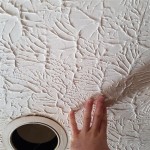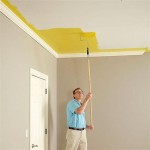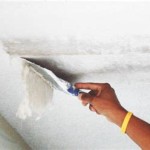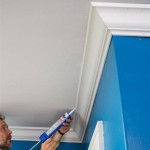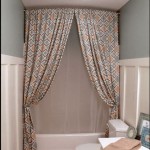How To Hang A Sheet From The Ceiling Without Nails
Hanging a sheet from the ceiling can serve various purposes, from creating a temporary room divider to fashioning an impromptu fort or enhancing the ambiance of a space for an event. The challenge often lies in accomplishing this without resorting to nails, which can damage the ceiling's surface. This article outlines several effective methods for hanging a sheet from the ceiling without nails, minimizing potential damage and offering flexibility in design and application.
The selection of the appropriate method depends on various factors, including the weight of the sheet, the type of ceiling, the desired duration of the hanging, and the aesthetic preference. It is crucial to consider these elements to choose the safest and most effective approach. Improper installation can lead to the sheet falling, potentially causing inconvenience or, in rare cases, minor injury. Therefore, meticulous planning and careful execution are essential for a successful outcome.
Using Adhesive Hooks
Adhesive hooks present a readily available and relatively simple solution for hanging sheets from the ceiling without nails. These hooks utilize a strong adhesive backing that adheres to the ceiling surface, providing a secure point from which to suspend the sheet. Several types of adhesive hooks are available, each with varying weight capacities. It is crucial to select hooks that can adequately support the weight of the sheet to prevent them from detaching from the ceiling.
Before applying the adhesive hooks, the ceiling surface must be thoroughly cleaned to ensure proper adhesion. Dust, dirt, and grease can impede the bond between the adhesive and the ceiling, potentially leading to the hook failing. A mild detergent solution and a clean cloth are typically sufficient for cleaning the surface. Allow the ceiling to dry completely before proceeding with the installation.
Carefully peel off the protective backing from the adhesive hook and firmly press it onto the cleaned ceiling surface. It is recommended to hold the hook in place for the duration specified by the manufacturer, typically around 30 seconds to one minute, to allow the adhesive to establish a strong initial bond. Avoid applying excessive pressure, as this can damage the ceiling surface, particularly if it is made of a delicate material such as popcorn ceiling. A consistent, even pressure is generally most effective.
After attaching the hooks, it is advisable to allow the adhesive to cure for the time recommended by the manufacturer before hanging the sheet. This curing period typically ranges from several hours to a full day, depending on the type of adhesive. This allows the adhesive to fully bond with the ceiling surface, maximizing its holding strength. Prematurely hanging the sheet can strain the adhesive and potentially cause the hook to detach.
Once the curing period has elapsed, the sheet can be carefully hung from the hooks. Depending on the design of the sheet and the hooks, various methods can be employed, such as using clothespins, binder clips, or simply draping the sheet over the hooks. Ensure that the weight of the sheet is evenly distributed across the hooks to prevent overloading any single hook. Regular inspection of the hooks is recommended to ensure they remain securely attached to the ceiling.
Employing Tension Rods
Tension rods offer another effective method for hanging sheets from the ceiling without nails. This approach is particularly well-suited for creating temporary room dividers or canopies, as it provides a stable and adjustable support system. Tension rods utilize a spring mechanism to create pressure against two opposing surfaces, thereby holding the rod in place.
To employ tension rods, it is necessary to have two parallel walls or surfaces within the desired hanging area. Measure the distance between these surfaces to determine the appropriate length of the tension rod. Select a tension rod that is slightly longer than the measured distance, allowing for sufficient tension adjustment. A rod that is too short will not provide adequate pressure, while a rod that is too long may be difficult to install and could potentially damage the surfaces.
Prior to installing the tension rod, ensure that the surfaces are clean and free of any obstructions. Dust, dirt, or loose paint can hinder the rod's ability to grip the surfaces securely. Wipe the surfaces with a damp cloth and allow them to dry completely before proceeding. Consider using non-slip pads or rubber grips on the ends of the tension rod to further enhance its stability and prevent slippage. These pads can be readily purchased at hardware stores or online retailers.
To install the tension rod, compress the spring mechanism and position the rod between the two surfaces. Slowly release the spring, allowing the rod to expand and exert pressure against the surfaces. Adjust the tension as needed to ensure that the rod is firmly in place and cannot be easily dislodged. It is important to avoid over-tightening the rod, as this can damage the surfaces or compromise the rod's structural integrity. A moderate amount of tension is typically sufficient to provide a secure hold.
Once the tension rod is securely installed, the sheet can be hung from it. This can be accomplished by draping the sheet over the rod, attaching it with clothespins or binder clips, or using curtain rings. Ensure that the weight of the sheet is evenly distributed along the rod to prevent sagging or instability. Regularly inspect the tension rod to ensure that it remains securely in place and that the tension is properly adjusted. Adjustments may be necessary over time due to changes in temperature or humidity, which can affect the rod's grip.
Utilizing Fabric Hanging Systems with Removable Strips
Fabric hanging systems offer a purpose-built solution for hanging sheets and other fabrics from the ceiling without the need for nails or permanent fixtures. These systems typically consist of a series of lightweight fabric panels or strips that are adhered to the ceiling using removable adhesive strips. The sheet can then be attached to these panels using various methods, such as Velcro, clips, or button snaps.
The key advantage of fabric hanging systems is their ease of installation and removal, as well as their ability to be repositioned without damaging the ceiling surface. The removable adhesive strips are designed to provide a strong hold while leaving minimal residue upon removal. These systems are particularly well-suited for temporary or seasonal decorations, or for renters who are restricted from making permanent alterations to their living space.
Before installing a fabric hanging system, carefully measure the desired hanging area to determine the number of fabric panels or strips needed. Select a system that is compatible with the weight and size of the sheet that will be hung. Ensure that the ceiling surface is clean and dry, as with the adhesive hooks method. Follow the manufacturer's instructions for attaching the removable adhesive strips to the ceiling. Typically, this involves peeling off the protective backing and firmly pressing the strip onto the surface.
Once the adhesive strips are in place, attach the fabric panels or strips to the adhesive. Ensure that they are securely attached and evenly spaced to provide a stable support system for the sheet. Allow the adhesive to cure for the recommended period before hanging the sheet. This will ensure that the adhesive is fully bonded and can support the weight of the fabric.
Attach the sheet to the fabric panels using the method specified by the fabric hanging system. Velcro is a common option, as it provides a strong and adjustable attachment point. Clips or button snaps can also be used, depending on the design of the system. Ensure that the sheet is evenly distributed across the panels to prevent sagging or uneven hanging. Periodically inspect the adhesive strips to ensure that they remain securely attached to the ceiling. If any signs of loosening are observed, reinforce the adhesive with additional strips or consider using a different hanging method.

How To Hang A Canopy From The Ceiling Without Drilling Holes

Diy Canopy Bed Without Drilling Holes

How To Hang Drywall Like A Pro Diy Family Handyman

How To Hang Curtains Around A Bed Without Drilling

3 Easy Ways To Hang Fabric On A Wall Without Nails Wikihow

How To Hang Drywall By Yourself Young House Love

Diy Canopy Bed No Drill Curtain Rod

How To Install A Beadboard Ceiling Pine And Prospect Home

Hang Art Without Nails How To

How To Hang A Hook From The Ceiling With Pictures
Related Posts

